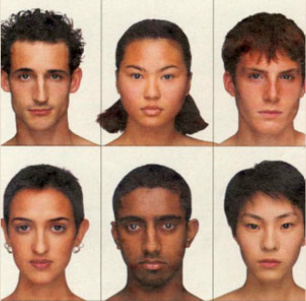
Face Variations by Ethnic Group
Introduction – Overview – Background
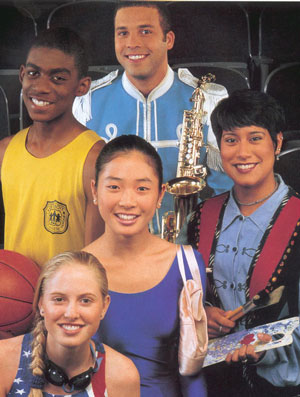
1. GEOGRAPHIC RACES (ETHNIC GROUPS) OF THE HUMAN SPECIES AND THE MASK:
In both women and men “ethnic” variations from the mask occur. However the more attractive a face is, regardless of ethnicity, the less the variations from the mask seem to occur. That is, in the attractive face from any ethnic group the correlation with the mask is extremely high.
It is somewhat artificial to put people into categories, since even people placed in the same category can have significant variations.
However, to be able to “box up” or group people according to their similarities sometimes helps to better understand them with respect to the general tendencies of the group. This is the case with human attractiveness and geographic races (ethnic groups).
2.THE NINE (9) GEOGRAPHIC RACES:
There are nine geographic races, each with particular genetic similarities. These geographic races include:
- Europeans (which include Middle Easterners and Mediterraneans)
- Eastern Indians
- Asians
- American Indians
- Africans
- Melanesians
- Micronesians
- Polynesians
- Australian Aborigines
3. ETHNIC SPECIFIC VARIATIONS FROM THE MASKS:
Every human face is a variation on the mask. Some faces vary only slightly and others vary significantly. Most are somewhere in between. Individuals within the same ethnic group tend to vary from the mask in similar manners. No one ethnic group as a whole is necessarily a closer match in general to the mask than any other.
The beautiful Caucasian (European, Middle Easterner, Mediterranean) face is arguably the most pervasive “beautiful face image” in the media, and as such has been generally assumed to reflect ideal human beauty. That is, the beautiful Caucasian face is often assumed to bear a unique and close resemblance to the “Mask”. Too often this “Caucasian beauty” has been assumed to reflect “Ideal Human Beauty” rather than ideal non-ethnic specific “beauty”.
There is nothing uniquely or specifically “Caucasian” about the Mask. The Mask is a “Species Genetic” configuration.
Frankly, a beautiful face from any ethnic group, whether it is European, Asian, African or any other geographic race is a very close to the Mask. Conversely, a face from any ethnic group, which closely approximates the form of the mask will be perceived to be attractive.
The average or plain Caucasian face no more closely approximates the “Mask” than the average or plain face from any other ethnic group. That is, no ethnic group on average more closely approaches the mask than any other and no ethnic group is more naturally attractive than any other. Each group has individuals who closely match the mask, those who deviate significantly from the mask and the majority who fair somewhere in between.
To date we have identified what seem to be three basic ethnic variations from the Mask:
- The Caucasian variation: This variation is generally applicable to Europeans, Middle Easterners, Mediterraneans, and Eastern Indians.
- The Asian Variation: This variation is applicable to individuals of Asian heritage and to some degree to American Indians.
- The African Variation: This variation is applicable to those of African heritage and to some degree to individuals of Melanesian, Micronesian, Polynesian, and Australian Aborigine descent.
Repose Frontal View – Ethnic Variations
The most important view of the face is the frontal view. It is in this view that we generally greet and converse with each other.
For this reason, in order to be recognized as uniquely human, we have evolved to resemble the “Mask” (the visual code of humanness) most closely, and vary from it the least, in the frontal view.
A face will almost always “fit” the Mask more closely in the Repose Frontal view than it will in the Repose Lateral view.
1. CAUCASIAN VARIATIONS – RF
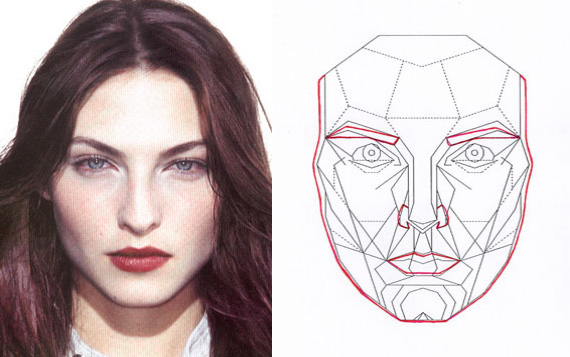
EUROPEAN VARIATION FROM RF MASK
Slightly vertically thin upper and lower lips
Flat eyebrow (very little arch)
Slightly wider nose
Lateral border of the face slightly wider than the Mask
Possible: Narrow eyes, longer vertical chin, longer nose
2. ASIAN VARIATIONS – RF
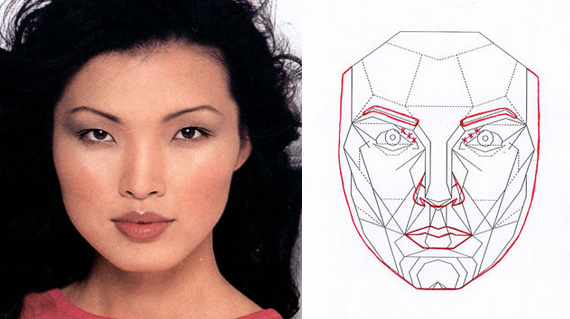
ASIAN VARIATION FROM RF MASK
Medial epicanthic fold
Lateral epicanthic fold
Lateral border of the face significantly wider than the Mask
Eye brows slightly superior to that of the Mask with shorter tails
Slightly wider nose and nostrils (nasal ala and nares extend laterally)
Superiorly positioned nasal columella creating a longer upper lip
3. AFRICAN VARIATIONS – RF
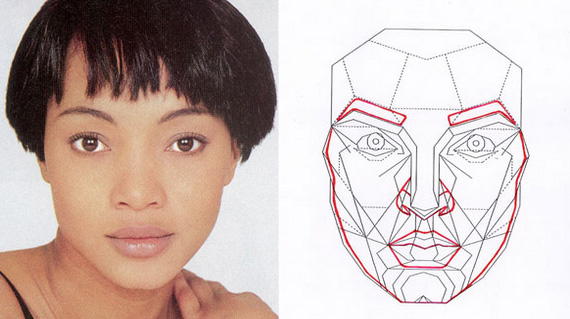
AFRICAN VARIATION FROM RF MASK
Lower lip 18 degrees wider from the corner of the mouth and extending to inferiorly to the labio-mental fold
Upper lip 18 degrees wider from the corner of the mouth and extending to the philtrum
Wider nose and nostrils (nasal ala and nares extend laterally) – such that the lateral aspect of the nostril (nare) is on the naso-labial fold
Eye brows in the brow zone superior to that of the Mask
Lateral border of the face slightly narrower than the Mask
4. COMBINATIONS OF THE BASIC ETHNIC VARIATION MASKS – RF
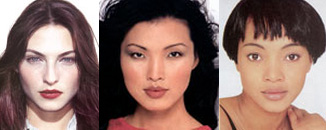
ALL 3 ETHNIC VARIATIONS FROM RF MASK
Ongoing research is focused on detailing more specific variations from the mask particularly with regard to the American Indians, Melanesians, Micronesians, Polynesians and Australian Aborigines.
Many beautiful faces consist of or resemble a combination or composite of subtle variations of ethnic qualities even if they are specifically derived from or genetically specific to a particular ethnicity that their face resembles. Although physical resemblance implies a probable genetic similarity it does not demand or guarantee a genetic similitude, particularly as a face approaches the “attractive” configuration of the archetypal mask.
Repose Lateral View – Ethnic Variations
There seems to be greater general variation from the mask in the lateral view. It is in this view that we retain more of our “individuality” with respect to our facial form.
It is in this lateral view that men and women seem to vary to the greatest degree, that individuals within the same ethnic group display the greatest variance, and that the geographic races display their most significant and distinctive differences.
The lateral view of the face is less critical for “recognition”, since it is generally in the frontal view that we perceive and interact with each other. This and the fact that this lateral variation seems to provide us with our particular “individuality” seems to be the most likely reason for this high degree of lateral view variation.
1. CAUCASIAN VARIATIONS – RL
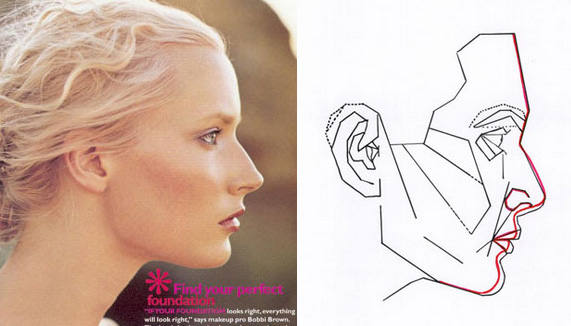
EUROPEAN VARIATION FROM RL MASK
Slightly vertically thin upper and lower lips
Retruded (flatter) upper and lower lips
Flat eyebrow (very little arch)
Slightly wider nose
Slightly superiorly placed caudal (inferior) aspect of the nose
Possible: slightly retruded chin, longer nose, wider more protruded nose, longer vertical chin
2. ASIAN VARIATIONS – RL
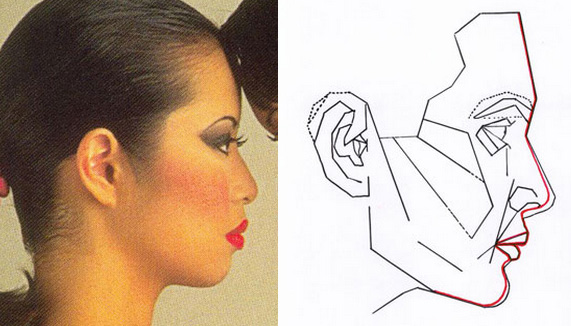
ASIAN VARIATION FROM RL MASK
Medial epicanthic fold
Lateral epicanthic fold
Eye brows slightly superior to that of the mask with shorter tails
Superiorly positioned nasal columella creating a longer upper lip
Right angle junction between the columella and the upper lip
Slightly retruded nasal dorsum and tip
Possible: slightly retruded chin
3. AFRICAN VARIATIONS – RL
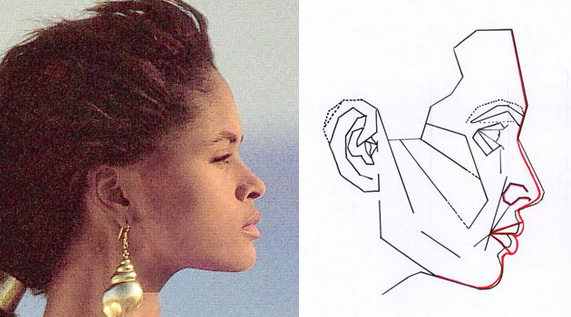
AFRICAN VARIATION FROM RL MASK
Lower lip vertically thicker
Upper lip vertically thicker
Eye brows in brow zone superior to that of the mask
Protrusive upper and lower lips
Slightly retruded nasal dorsum and tip
Possible: slightly retruded chin
4. COMBINATIONS OF THE BASIC ETHNIC VARIATION MASKS – RL
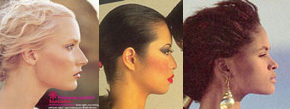
ALL 3 ETHNIC VARIATIONS FROM RL MASK
Ongoing research is focused on detailing more specific variations from the mask particularly with regard to the American Indians, Melanesians, Micronesians, Polynesians and Australian Aborigines. Many beautiful faces are or resemble a combination of subtle variations of ethnic qualities even if they are specifically derived from or genetically specific to a particular ethnicity that their face resembles. Although physical resemblance implies a probable genetic similarity it does not demand or guarantee a genetic similitude, particularly as a face approaches the “attractive” configuration of the archetypal mask.